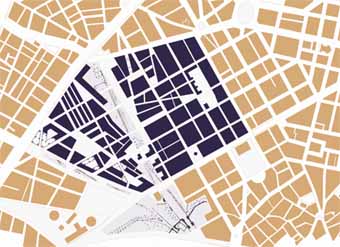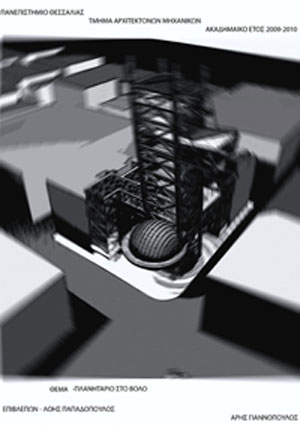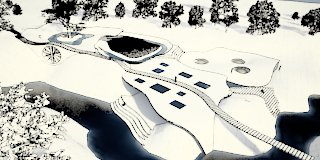

The deserted and abandoned rooftops’ space has special architectural particularities which occasionally express a charm. In order to be turned to a living area, the constructed place is recomposed and new structures provide protection from bad weather condition while at the same time the special face of the place is preserved. The recomposing method is being made through collage. Photo-captured objects from the rooftops combined with each other and regrouped, regenerate a new environment above the city.
Supervisor: Manolidis Kostas
Reference Number: 316


The thesis explores ways of intervention in the area of Metaxourgio in Athens with the aim of coexistence of the elements of diversity (temporal, spatial, functional, cultural). At the same time, it explores the consequences of their implementation in the character of the region, but also in Athens generally, to the extend that the area constitutes part of the historical centre. The current character of the area and the general availability of the state to upgrade it as residence region near the historic centre are taken into consideration as data. The main tool of the study is the emergence of archaeological sites (Dimosion Sima, Iera Odos) and evidence of the recent history of the region (neighbourhood of 19th-20th centuries, factory of Metaxourgio).
In the analysis and recognition of the status quo in the region are taken into account a variety of parameters in order to reach more globally its intense character. Is examined the location of the area in the agglomeration of Athens and the degree of correlation with the wider region of the capital and critical scope positions of city level (Kerameikos archaeological site, Technopolis-Gazi, Omonia Square, Psirri - Plaka – Monastiraki, Botanicos) . Are recorded the historical dimension of the region from ancient times until today, the way of its integration in the plans of the capital of the new Greek state and its evolution during the 19th and 20th century. Are approached the social and anthropological dimension of the region as it stands today and the different groups that make it up within the context of migration, abandonment and obsolescence of the centre on the one hand and the simultaneous settlement of the medium or large income groups on the other hand. Are approached, also, issues of urban fabric and block, as well as their production process in time and space. In this context, are explored of course, the historical, archaeological and urban trails. These traces constitute alignments, whether tangible or intangible waste-products of the past the latent presence of which is inherent in the present contributing to the current produced space and character of the region.
To the designing proposal lead the conclusions of the analysis. Are explored ways of management of urban fabric in order to determine the space produced through the potentially built (block, free building) or unbuilt (street, square) elements of space. Is attempted the control of the conflictual relationships developed in components in such a way that the differentiation of one changes the balance of the system. General and specific alignments of urban fabric and links of points of special interest are determined. As critical positions in the region are defined two zones transverse in Piraeus Street: Giatrakou Square and the building of Metaxourgio, and the zone which is identified with Dimosion Sima of the ancient city. However, equally critical is the area located between the two as a transition area.
The questioning included in the proposal concerns the coexistence in space and time of data obtained at a different time, in different social and cultural contexts since the region constitutes a palimpsest. The objective is the modern reading of urban space through these points of difference.
Supervisors: Zarkia Kornilia , Thermos Kimon
Reference Number: 265


In the crossing roads, Fillelinon and Dimitriados, in Volos, a parking is authorized to be built. In occasion of this, this paper there is proposing an alternative solution of use of this space. This solution consists of a planetarium “with a museum of contemporary art” in order to exploit the special point of this geographical point in the town, which can act as a catalyst to its cultural and the social life. The site is located in the centre of the town among other land uses such as recreation, purchasing, education (the central university of Thessaly is located nearby), park and finally it is close to the port. All these facts, makes the site a location with many advantages for a building of this kind.
The building will include spaces and services for the daily inflow - outflow of information in order to create a continuous "relationship" with the residents of the city. Its functions are summarized to the followings:
• A planetarium with capacity for 80 people inside diameter of 12 meters and 22 degrees inclination,
• A digital library (which can offer much information without the need of big space)
• Four rooms of workshop that can provide reproduction and transformation of useless things into useful
• Two major areas reporting 450 and 350 sqm respectively, in which, there could be displayed works of workshops and any other report that can be accommodated
• And finally recreation rooms
Much attention was paid, in the design of the building, in the way that it was assigned. That happened in order to be created a square, which could continue the urban fabric of Dimitriados with an open space worthy of the size of the building. Also, there was a predisposition that the architecture of the building could be a mark for the city so visually as "historical" as well. So, the height of the building could be said to be fairly large compared to the city and that has elements that refer to industrial architecture in order to link with the city's history.
Supervisor: Papadopoulos Lois
Reference Number: 257


The project’s subject concerns the building development of multi-housing.
This project studies the spaces which are created by the multi-housing type of buildings, as well as, the spatial needs of contemporary housing.
The result of this project is the design approach of a contemporary multi-housing building.
Supervisor: Paniyiris Costis
Reference Number: 254


The special condition that is generated by the transit of a river through a place becomes the cause for the design investigation of a space that aspires to become an amplification field of water properties (weight, levitation) and of its behavior (movement, liquidity) in order to multiply the experiences that these properties can transfer to the visitor. The participation of the water is the key element in the theoretical and design level, and its action is incorporated not only in the forming procedure but also in the function of the compositional space.
Supervisor: Papadopoulos Lois
Reference Number: 314
Developing my Special Research Topic, I tried for a deeper methodological and designing approach of Chalandri’s Stream. In the urban web, we usually conceived the landscape as a “parenthesis”, as a “gap” in the continuation of the web.
A “natural void” in the human interventionism, that is expressed by the continuous growth of the urban web. My intention is to place for once again the glen in the “heart of” of the city of Chalandri, managing the water’s flow that I consider as its sovereign element, “opening” the stream to the urban web and “revealing” it to the city. Therefore, I tried to work in two different levels, on one side in the interior of glen with its pre-existing elements (vegetation, water, gardens) and on the other side activating and connecting pre-existing public uses.
My Final Thesis aims for repositioning the glen in the “heart of” city. Through my proposed thesis, the glen will begin to show more “accessible” and “friendly” to visit for the citizens. This could happen via the main elements of my architectural proposal: continuous paths (from the beginning to end of my studied region) and accessible from all (bent of ramps 6-7%), direct access from the height of city at multiple points, recreation, entertainment, benefit of cultural events via the new theatre, swimming, game in the designed region full with sand, dew and flood-preventing protection.
The design aims to redefine the relation between natural landscape that interferes in the urban web. Creating new uses for the citizens, with a minimal architectural design, I aim not to create a “plastic” scene of theatre, but I aim for a factual pastime with the landscape and for the return of bourgeois to the nature. Thus, I aim for placing the nature, for once again, in the everyday routine of bourgeois and the renegotiation of the present relation of bourgeois with the landscape.
Supervisor: Kouzoupi Aspassia
Reference Number: 281


The objective of the present dissertation is the design and construction of three buildings in the village of Milies in Mount Pelion.
The selection of the topic is tightly connected to the author’s most intimate memories of her childhood. Flashes from the family life in the old house in Milies have emerged her wish to move permanently to this village in the future. This dissertation is perhaps the first attempt to realise her dream. In every visit in the old house she recalls moments of the family gathering around the wooden table. The most intense feeling however, i.e. that of peacefulness, serenity and security, comes from the interior of the house, which brings in her mind all the personal moments she has experienced in various parts of the house, such as the wooden ledge of the window or the divans around the fireplace. Those memories have become a kind of legacy that motivated her to carry out the dissertation, which is presented in brief hereafter.
The first part describes the historical, geographical, political, economical and social background of the place focusing on those special features that compose its character. Milies at all times has been one of the wealthiest villages in Mount Pelion. According to tradition, its name is accredited to the residents of village Milies in the island of Evia, who attempted to escape from the pirates’ attacks and founded a new village at the current position in Mount Pelion. This story explains among others the scarce seaview one has from the village. During the 19th century architecture in Milies followed the Northern Greek trend: wealthy owners brought craftsmen from Epirus and Macedonia to build impressive mansion-houses. Years after, in 1943 the village suffered under the command of Nazis, who exercised retaliation and burned down the majority of residences. Later, the tragic outcomes of the earthquakes in 1955 and 1956 as well as the general economical and political instability that Greece had been facing at that time led to the decline of the Pelion architecture, leaving only a few samples of its traditional style. These samples constitute inspiration for the new buildings that keep increasing in our days.
In contrast to the architecture one may face today when visiting Milies, this dissertation proposes the construction of a different type of mansion-house, relatively distanced from the strict typical framework of the Pelion architectural trend. Goals of the dissertation are the synthesis around the existent house, the smooth integration of the mansion-houses in the traditional residential web and their development using the author’s childhood memories. The general objective is the construction of three different independent residential cells which will occupy the whole land available and will intercommunicate through a yard. This yard constitutes a structural part of the construction since it functions in a way as the meeting point for the family, like in the old house. An open-air sitting room and an external kiln are built centrally in this yard. On a theoretical plane the construction of the yard directs to the lounge room of the old mansion-houses, where families used to gather.
The three houses are built circumferentially in the building plot, all viewing towards the existent old building, creating in this way a sense of interconnection between the past and the present and also shedding a feeling of introversion allover the block. The two houses connect to each other in the floor via a common veranda, while the third house is totally independent. In several circumstances, the windowsills function as seats, interior or exterior, linking the inside with the outside. The concept of πρισματικοτητα is used in various parts of the block. The entrance to the building plot is from a slot on the side wall. Stepping out of the entrance there is a fabulous panoramic view towards the sea, which is achieved due to the proper “breaks” in the ground floor walls of the two houses.
As for the materials, the construction uses local stuff, such as stone and wood. The structure is 0.50m thick like the old stone structures, despite being of cement. The window recesses and the windowsills, which can be used as benches, are made of wood. The roofs are constructed in such a way that one seems as an extension of the other forming thus a common imaginary roof that covers the entire block bringing about the impression of one house. From the inner side, the roofs are wooden, while from the outer side they are built with stone from Mount Pelion, which has the same colour with the cement used for the walls, ensuring thus an aesthetic harmony. The facets of each floor are also wooden. The elaboration of the openings in every floor is based on the memory of the knit lace that is widely used as material for curtains in Pelion. In other words, woods are placed in a way to follow the surge of the lace so that the whole scenery reminds one of it, as if one looks through a lace curtain.
To sum up, this dissertation attempts to bring together the past and the present using up-to-date methods and techniques so that a modern block of mansion-houses can smoothly integrate into the traditional local architecture and its enormous cultural identity.
Supervisor: Lykourioti Iris
Reference Number: 256


The current essay has a wide range of quests that starts from rhythm and body relationship and extends to space. Βy constant alternations in its range the drawing of gathered data is attempted. These alternations define the scale of space study as well as the kind of recommended interventions. Each time the selected for investigation space defines a relationship system of its own too. Our occupation with rhythm leads us to the choice of a specific characteristic of rhythm that will constitute afterwards our central subject. This characteristic is syncopation. The relationship system in which it is set is the artificial – natural landscape and specifically torrent Krausidon in the city of Volos. At the same time the system torrent – bed is examined. Syncopation is used in our final project as notional intention but as a product of planning process as well.
Supervisor: Gavrilou Evelyn
Reference Number: 310

